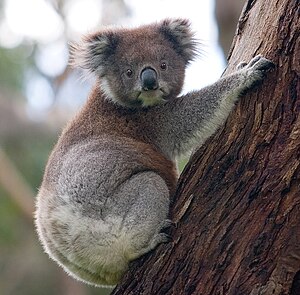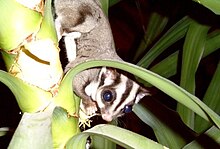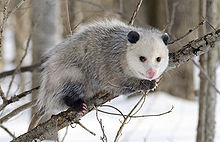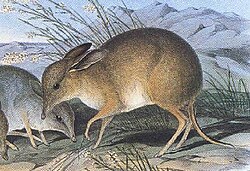Marsupials
| Marsupials | ||||||||||||
|---|---|---|---|---|---|---|---|---|---|---|---|---|

Koala ( Phascolarctos cinereus ) |
||||||||||||
| Systematics | ||||||||||||
|
||||||||||||
| Scientific name | ||||||||||||
| Marsupialia | ||||||||||||
| Illiger , 1811 |
The marsupials (marsupials, the crown group of marsupials; extinct representative of the trunk group including one also speaks of the group of Metatheria) or marsupials form a subclass within the mammals (Mammalia). They differ from the higher mammals or placentas (Eutheria), among other things, in that the young are born in a very early, embryo-like stage and then often grow up as passive carriers in a mother's pouch. Today, on the one hand, on the continent of Australia and in Southeast Asia east of the Wallace Line and, on the other hand, in America , about 320 marsupial species live together, and thus around 6 percent of all modern mammal species.
anatomy
Marsupials have the characteristics typical of mammals such as a coat made of hair , the three ossicles , the diaphragm and others that are described in the body structure of the mammals . In addition to the noticeable differences in the way of giving birth, there are a number of anatomical features that distinguish them from the higher mammals.
Skull and teeth
The construction of the skull has some peculiarities. In general, the skull is relatively small and narrow, which is reflected in a smaller - and more simply built - brain compared to higher mammals with the same body size . A. has no corpus callosum . The tears hole ( foramen lacrimale ) is located in front of the orbit , the zygomatic bone is increased, and further extends to the rear, and the angular extension ( processus angularis ) of the lower jaw is bent toward the middle. Another feature is the palate plate, which, unlike the higher mammals, always has several foramina (openings). The teeth of these animals also differ in some respects from those of the placenta animals: with the exception of the wombats , all taxa have a different number of incisors in the upper and lower jaw. The early bag mammals had a tooth formula of 5 / 4-1 / 1-3 / 3-4 / 4, that is, per half of the jaw they have five (upper jaw) or four (lower jaw) incisors , one canine , three premolars ( premolars ) and four molars (back teeth), so a total of 50 teeth. Some taxa such as the opossum still have the original number of teeth, in other groups there has been a diet-related reduction in the number of teeth. Even today, marsupials have 40 to 50 teeth in many cases, significantly more than comparable placenta animals. What is noticeable here is the high number of incisors in the upper jaw (up to ten) and that there are more molars than premolar teeth. A change of teeth only takes place in the 3rd premolar, all other teeth are already created as permanent teeth. After their eruption, the molars experience a horizontal displacement, which means that they move forward in the course of life and are most worn out there.
Remaining physique
In the skeleton of the rest of the body, there is little general features. In addition to details in the structure of the ankle , the pouch bones ( ossa epubica ), two bones protruding forward from the pubic bone of the pelvis, are characteristic of these animals . Since these are also present in males and in bagless species, it is assumed that these bones originally had nothing to do with reproduction, but served the muscle attachment for the movement of the hind limbs. Since the egg-laying mammals also have pouch bones, it is assumed that this could be an original mammalian feature. In the structure of the reproductive organs, the marsupial mammals also differ from the higher mammals. Their reproductive tract is doubled: females have two uteri and two vaginas , and before birth a birth canal, the pseudovagina, is formed between them . The males also have a split or double penis with a scrotum in front of it .
A pouch ( Marsupium ) is present in many, but by no means all, species. Some marsupials have a permanent pouch, with others it only develops during the gestation period, still other species such as the mouse opossums are bagless, the young are then only hidden by skin folds or in the fur of the mother. The arrangement of the bag is variable in order to give the offspring the greatest possible protection depending on their lifestyle. The hopping kangaroos have the pouch opening at the front, while many other species that walk or climb on all fours have the opening at the back. Mostly only females have a bag, however, in the case of the swimming bagler living in the water, this is also present in the males and serves to accommodate the scrotum in it when swimming or running fast.
General and convergences

Marsupials have adapted to a wide variety of habitats, which is reflected in the great diversity in their physique. The largest living marsupial is the red giant kangaroo with a height of up to 1.8 meters and a weight of 90 kilograms, although extinct species such as the Diprotodon were significantly larger and heavier. The smallest members of this group are the flat-head pouch mice , which often only reach a length of 5 centimeters and a weight of 5 grams.
Some species show amazing parallels to higher mammals and are prime examples of convergent evolution . The extinct thylacine was very similar to the placental wolf . A gliding membrane and the associated ability to glide have developed independently of one another in some marsupials ( e.g. gliding squirrel and giant glider ) and some higher mammals ( e.g. gliding squirrel and giant glider ). Some groups - such as opossum rats , pouch mice or pouch martens indicate the similarity to placenta in their name. Other groups such as the kangaroos , on the other hand, have no placental counterparts at all.
Distribution and habitats
Marsupials are native to the American continent and Australia, including the Southeast Asian island world. Within America, most species live in South America , some species are also common in North and Central America . The northernmost range has the northern opossum , which in the wake of humans has expanded its range over parts of the USA and even Canada .
In the Australian area, most species are native to Australia or New Guinea . In the eastern continental to Asia belonging to Indonesia , from Sulawesi and the Moluccas to the east, there are marsupials. The western limit of its range in the Indonesian archipelago is called the Wallace Line. In the east their distribution area extends to the Solomon Islands ; on the other islands of the Pacific Ocean , as in New Zealand , there were originally no marsupials.
Marsupials have colonized a wide variety of habitats: they can be found in forests, grasslands, in mountainous terrain and also in deserts. It is noticeable that in these animals - in contrast to the higher mammals - hardly any species have adapted to the water as a habitat, only the floating bagler and to a lesser extent the thick-tailed rat live an aquatic way of life and are webbed and sealed with a waterproof bag for life armed in the water. Many species are tree-dwellers and show good adaptations to this habitat with opposable thumb and prehensile tail , others are pure ground dwellers.
Way of life
As diverse as the habitats of the marsupials are their ways of life, and it is difficult to make generalizations. There are diurnal as well as crepuscular or nocturnal, solitary and group living species. Compared to the higher mammals, however, their social behavior is rather underdeveloped. Many species live solitary or in loose associations without permanent social structures; Groups with complex rankings are rare.
The diet also varies considerably. There are pronounced herbivores (herbivores) such as kangaroos , wombats, and koalas, as well as omnivores (omnivores) such as the opossum and nasal pus . Carnivores (carnivores) can be found, for example, in the Mausopossums and the predatory butts . After the extinction of the large carnivorous species such as bags lion and thylacine is Tasmanian Devil is the largest surviving carnivorous marsupial today.
Reproduction

In addition to the peculiarities of the marsupials in the structure of the reproductive tract described above, they also differ significantly from the higher mammals in the mode of reproduction . Most species do not develop a true placenta . Due to the lack of trophoblasts , there is no immunological barrier between the germ and the mother, so that the gestation period must be completed before the mother's immune defense becomes fully effective. The germ is fed through a yolk sac . However, there are also some species that have a real placenta, including the nasal sac or the koala . The gestation period is short, between 11 and 43 days. It is shortest in the narrow-footed pouch Sminthopsis macroura with only 10.5 to 11 days.
The newborns are born through a birth canal located between the vaginae, which in many species is specially formed for birth. Newborn marsupials are small and underdeveloped compared to the higher mammals. The weight of the litter is always less than 1% of the mother's weight, the proboscis babies weigh only five milligrams and are therefore the smallest newborn mammals of all. Newborn marsupials have only rudimentary organs; only the forelimbs are well developed, as the offspring have to crawl to the mother's teats on their own.
Not all marsupials have a bag in which the teats are located. In some species, the young hang freely on the mother's teat, only hidden by their fur or skin folds. Newborns cling to the teat with their mouths and remain firmly attached to it during the first few weeks of life. The suckling period lasts longer compared to the higher mammals.
In the past, the marsupials' way of giving birth was regarded as a primitive method that was underdeveloped compared to that of the higher mammals. The displacement of some marsupials by imported higher mammals has also contributed to this prejudice. Apart from the fact that this "prejudice of progress" towards the development of humans has been largely replaced in modern systematics and that several marsupial species have very successfully expanded their range, the marsupial method of reproduction also offers advantages: on the one hand, the exhausting gestation period for the mother is shortened In others, a young animal can be brought into the world much faster than with placentation if the one born earlier should die. According to calculations by MB Renfree (quoted from Kemp, 2005), the mother's entire energy expenditure is almost the same for both modes of reproduction, but in the case of the marsupial it is distributed over a longer period of time. As a result, higher mammals are better adapted to reproduction under climatically unfavorable conditions, in which sufficient food is only available for a short time.
Development history
Most scientists believe that sac and higher mammals share a common ancestor, the common taxon is called Theria , and is the sister taxon of the egg-laying mammals ( Protheria ). However, some researchers support the theory that sac and ursal mammals form a common taxon, Marsupionta , which is the sister taxon of the higher mammals. This theory is based on certain molecular genetic similarities, but is a minority opinion.
Origin and early representatives
Until recently, Mesozoic marsupials were known only from North America , and this continent was long believed to be the origin of this group. However, recent findings in East Asia contradict this theory. The oldest known representative is the approximately 125 million year old species Sinodelphys szalayi , the remains of which were found in the Chinese province of Liaoning . Sinodelphys szalayi , however, is not the immediate ancestor of today's marsupials, but rather a larger group that includes some little-known extinct Asian taxa such as the Deltatheroida and the Asiadelphia .
North America, Eurasia and Africa
Descendants of this earliest line of development must then have immigrated to North America . The vast majority of the Cretaceous finds , which also contain the ancestors of all marsupials living today, come from this continent . One of the earliest known North American representatives is Kokopellia juddi , whose age is estimated to be around 100 million years. This was followed by a large amount of radiation ; several families are known from the Upper Cretaceous North America. With Alphadon already a representative of today's living opossums , even early forms of order of Paucituberculata that today in the shrew opossum lives were found.

The North American marsupials largely died out at the end of the Mesozoic Era, probably caused by the immigration of placental mammals from Asia. In the Cenozoic there were only very few genera (from the Peradectidae family ), but by the Miocene at the latest , these forms were also extinct. Only about 3 million years ago, when a land bridge was formed between North and South America with the Isthmus of Panama in the late Pliocene , could South American marsupials (opossums) immigrate to northern America in the subsequent Great American Fauna Exchange .
Representatives of the Peradectidae also spread to Africa , Europe and Asia in the Cenozoic . However, this process was limited to a few species that could not establish themselves permanently and also died out in the Miocene at the latest. Since then there have been no more marsupials in Eurasia and Africa.
South America
It is not known exactly when the marsupials reached South America . The first finds that can be assigned to this group come from the early Paleocene ("Tertiary"). Since South America was separated from the rest of the continents for much of the Cenozoic , a unique fauna developed there, including three orders of marsupials. On the one hand there were the opossum rats (Didelphimorphia), on the other hand the Paucituberculata , which developed a great diversity of species and survive today only in the form of the mouse opossum. The third group were the now extinct Sparassodonta , also known as "pouch hyenas", which were the only larger carnivores on this continent, alongside terror birds (Phorusrhacidae) and terrestrial crocodiles ( Sebecidae ). The best-known representative of the Sparassodonta is probably the saber-toothed cat-like Thylacosmilus .
Many marsupial species in South America became extinct along with other endemic mammal species when South and North America were connected by the land bridge of Central America around 2.5 million years ago and species flowed in from the north to the south. However, some marsupial species were subsequently able to expand their range to Central and North America.
Antarctic
Even if only a few fossils have been found so far, there is largely no doubt that the Antarctic continent was home to a rich marsupial fauna in the Cenozoic era until it was glaciated. The only finds were made on Seymour Island off the Antarctic Peninsula and date from the mid or late Eocene . The species found are related to the animals living in South America at the time , this connection is well documented in paleobiogeographical terms , as the Drake Passage (which is now between South America and the Antarctic) was only created around 35 to 30 million years ago. In the course of the associated emergence of the Antarctic Circumpolar Current , the Antarctic was frozen and all land mammals living there became extinct.
Australia

Almost nothing is known about when and in what form the marsupials came to Australia . Since the Australian continent did not break away from Antarctica until the beginning of the Eocene , immigration via a previously ice-free Antarctica is the only logical way to settle. The oldest marsupial finds come from Murgan in southeastern Queensland and are assigned to the Tingamarra local fauna , named after Tingamarra , an animal similar to, but not related to , the common ungulates . This fauna is dated to the early Eocene and is 54.6 million years old , according to a measurement made using potassium-argon dating . However, since the finds consist largely of jaw fragments and teeth, a systematic classification is difficult. Then there is another big gap in the fossil record. It was not until the late Oligocene (around 25 million years ago) that there were finds again. The ancestors of most of today's families are known from this era and the Miocene . There are hardly any groups that are completely extinct. With the exception of the genus Yalkaparidon , which is characterized by its striking teeth , all finds can be classified in one of the four orders currently living in Australia (see below). Until the arrival of humans, marsupial mammals remained the dominant group of mammals in Australia, except for a few representatives of the bats and old world mice , no higher mammals were able to establish themselves there.
In the period from 51,000 to 38,000 years ago, there was a mass extinction of large mammals in Australia. Among other things, the giant diprotodons , three-meter-high kangaroos like Procoptodon or marsupial lions like Thylacoleo carnifex were affected by this . This phenomenon was not limited to Australia, however; Large mammals became extinct almost worldwide at the end of the Pleistocene (see also the relevant section under Mammals ). There is a fierce controversy about the causes of this extinction between proponents of the overkill hypothesis , who blame human hunting for it, and other researchers who blame climatic changes during the ice ages . The overkill hypothesis is supported by the fact that similar processes have also been observed on other continents, that the extinction correlates roughly with the settlement of Australia by humans and that no other extinction process has found such a restriction on body size. Opponents of the hunting hypothesis argue that the primitive hunting methods and the low population density of early humans could not have had such a great impact on the population size and point to the cold and drought caused by the glaciation of large parts of the earth. Recently, the theses that a mixture of both factors are to blame for the mass extinction have increased. For the populations already affected by climatic changes, hunting was the decisive factor for the extermination.
Internal system

In earlier classifications, all marsupials were grouped together in a single order , Marsupialia. Modern research differentiates more strongly and divides it into seven orders, five of which can be grouped together.
- The opossum rats (Didelphimorphia) are perhaps the most primitive group of marsupials. Of the around 110 species, the opossums are probably the best known.
- The Mausopossums (Caenolestidae) are the only recent representatives of the once richly shaped order of the Paucituberculata . They live in western South America and show similarities with the shrews in their physique and way of life .
- The Australidelphia consist of five orders and summarize the species living in the Australian area as well as Dromiciops from Chile:
- The genus Dromiciops from southern South America , the only recent representative of the order Microbiotheria and is more closely related to the Australian than with the other American marsupials.
- The pouch mole (Notoryctemorphia) are composed of only two species. They show similarities with the moles in their physique and way of life .
- The Predator-like (Dasyuromorphia) are predominantly carnivorous animals. They include the pouch martens , the pouch mice , the marsupial devil , the numbat (ant colonies) and the pouch wolf, which died out in the 20th century .
- The nasal sacs or bandikuts (Peramelemorphia) are a relatively species-poor group of ground-dwelling omnivorous animals.
- The Diprotodontia are the most species and shape-rich group. They are compiled on the basis of morphological characteristics of the teeth and toes and summarize, among other things, the kangaroos , the wombats , the koala and several families of gliding or tree-dwelling marsupials. Several extinct groups such as the Diprotodonts or the bag lions are counted among the Diprotodontia.
The relationships within the marsupials are still controversial and the subject of scientific discussion. It is considered certain that the opossum is the sister taxon of all other marsupials. This is expressed in the following diagram:
| Marsupials (Metatheria) |
|
||||||||||||
|
|
The Australidelphia are most likely monophyletic , that is, they include all descendants of a common ancestor. There is uncertainty about the lineages within this group. In 2003, Heather Amrine-Madsen presented the following cladogram based on molecular genetic comparisons (quoted from Kemp, 2005):
| Australidelphia |
|
||||||||||||||||||||||||
|
|
Other approaches, however, combine the nasal sacs and Diprotodontia to form a taxon Syndactyli, which is morphologically supported by the fused together second and third toes of the hind limbs, but possibly only represents an analogy . Still other studies place the Microbiotheria and the Diprotodontia in a common lineage and see the nasal sacs as sister taxons of the rest of Australidelphia. So there is no generally recognized phylogenetic system of the marsupial. The attempt to systematize is made more difficult by large gaps in the fossil record - for example, there have been no finds of the Australian species between the time 55 million years ago and the time 25 million years ago, when today's orders were largely established.
Humans and marsupials

Like many other mammals, several species of marsupials have been hunted by different peoples for their meat and fur. The extent to which this type of hunting is mainly responsible for the extinction of large Australian mammals in the Pleistocene is controversial (see above).
The Australian marsupials were badly affected after the arrival of the white settlers in the 19th century. Hunting, habitat destruction by conversion to agricultural land and competition from released animals (such as foxes , rabbits and domestic cats ) endanger many species. Some marsupial mammals have become extinct, including four species of kangaroo , two species of rat kangaroo , seven nasal sacrum, and the thylacine . Many other species only inhabit a fraction of their original range and are considered threatened. Other species have been able to cope better with the changes: the Kusus are more widespread than ever as cultural followers and the giant kangaroos are also among the more widespread animals.
The situation of marsupials is somewhat better in America, although here too many predominantly forest-dwelling species are endangered by deforestation. The northern opossum was able to expand its range in the course of the colonization of the continent by the whites and is now also found in large parts of the USA and even Canada .
literature
- TS Kemp: The Origin & Evolution of Mammals. Oxford University Press, Oxford 2005, ISBN 0-19-850761-5 .
- Malcolm C. McKenna, Susan K. Bell: Classification of Mammals - Above the Species Level. Columbia University Press, New York 2000, ISBN 0-231-11013-8 .
- Ronald M. Nowak: Walker's Mammals of the World . 6th edition. Johns Hopkins University Press, Baltimore 1999, ISBN 0-8018-5789-9 (English).
- DE Wilson, DM Reeder: Mammal Species of the World. Johns Hopkins University Press, Baltimore 2005, ISBN 0-8018-8221-4 .
Web links
Individual evidence
- ↑ Karen H. Black, Michael Archer, Suzanne J. Hand, Henk Godthelp: The Rise of Australian Marsupials : A Synopsis of Biostratigraphic, Phylogenetic, Palaeoecologic and Palaeobiogeographic Understanding. In: JA Talent (Ed.): Earth and Life. International Year of Planet Earth, 2012, pp. 983-1078, doi : 10.1007 / 978-90-481-3428-1_35 , ISBN 978-90-481-3427-4 .

